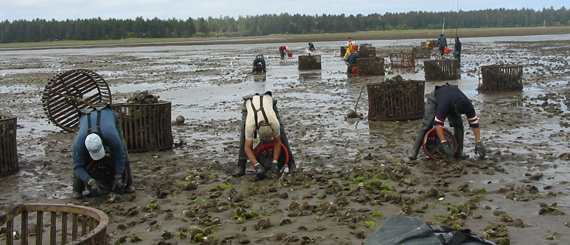Aquaculture

Workers harvesting oysters on tidelands. DNR photo
For more than a hundred years, the state Department of Natural Resources (DNR) and its predecessor has offered leases to support aquaculture operations that grow oysters, clams, and mussels using a variety of growing methods, including: bottom, bag, intertidal long lines, and floating shellfish rafts.
Through leases, growers and the state generate revenue that supports local economies, pays for management and restoration of state aquatic lands, and provides nationally recognized abundant seafood. The structure of DNR's aquaculture leasing program is laid out by state law.
There are some 2,100 acres of state-owned aquatic land under lease for aquaculture, mostly tidelands. About 80 percent of the commercial aquaculture leases are for oyster culture. State leases in Puget Sound, Willapa Bay, and Grays Harbor, are part of a successful industry that provides seafood products for domestic and export markets.
The State Legislature’s policies promote a diverse shellfish farming industry, and DNR's role is to preserve and enhance water-dependent uses such as aquaculture, and to provide opportunities to utilize renewable resources, including shellfish. Fees are collected to compensate the public for the exclusive nature of the leases, and every effort is made to mitigate the effect of reduced public access across those leased areas. Like other leases of state-owned aquatic lands, aquaculture leases are negotiated based on the direction of the 1984 Aquatic Lands Act to manage the lands and resources in ways that protect the environment while encouraging navigation and other water-dependent uses, renewable resources, and public access—and earn revenue where appropriate.
Lease State Aquatic Lands for Aquaculture
Aquaculture leases for state aquatic lands are handled by DNR’s Aquatics Districts. Application materials, general leasing information, and answers to specific questions can be addressed by contacting the appropriate District Region Office. For geoduck aquaculture leasing, see DNR's Geoduck Aquaculture Program.
Funds for Management, Restoration & Local Access Projects
About half of the revenue generated from aquaculture leases is used for management and protection of state-owned aquatic lands statewide, and half is deposited into the Aquatic Lands Enhancement Account (ALEA). ALEA provides matching funds to help purchase, restore improve, and protect aquatic lands. Matching funds also help build local projects that improve public access to aquatic lands statewide.
Tribal Shellfish Sharing
Treaties signed with western Washington Indian Tribes in 1854 and 1855 reserved the right for tribes to harvest fish and shellfish from all usual and accustomed fishing areas in common with citizens of Washington. In 1994, Judge Edward Rafeedie upheld the right of Treaty Indian tribes, or their successors in interest, to harvest up to fifty percent of the harvestable surplus of shellfish from natural shellfish beds. To implement the ruling, a procedure for notification of tribes about DNR aquaculture leases and potential harvest agreements on state lands was formalized in an implementation plan. See the State and Tribal Sharing of Shellfish website.

